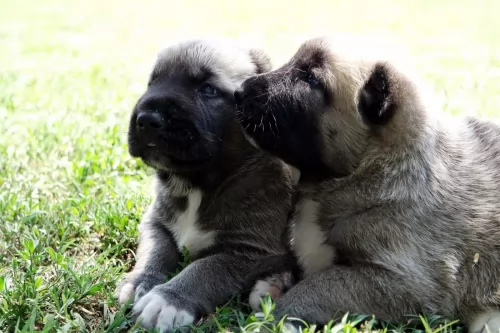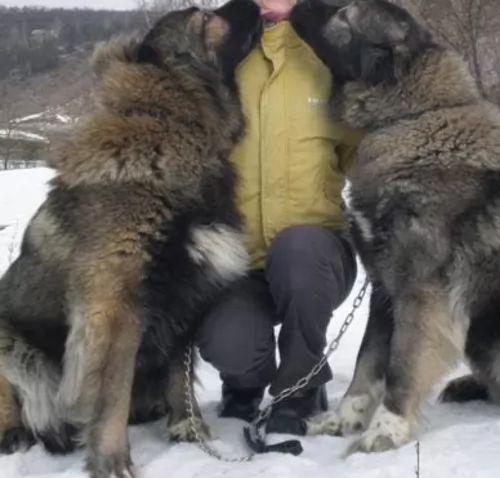 MyDogBreeds
MyDogBreeds Sealyham Terrier is originated from United Kingdom but Kars Dog is originated from Turkey. Sealyham Terrier may grow 60 cm / 23 inches shorter than Kars Dog. Sealyham Terrier may weigh 71 kg / 156 pounds lesser than Kars Dog. Both Sealyham Terrier and Kars Dog has almost same life span. Sealyham Terrier may have less litter size than Kars Dog. Both Sealyham Terrier and Kars Dog requires Moderate maintenance.
Sealyham Terrier is originated from United Kingdom but Kars Dog is originated from Turkey. Sealyham Terrier may grow 60 cm / 23 inches shorter than Kars Dog. Sealyham Terrier may weigh 71 kg / 156 pounds lesser than Kars Dog. Both Sealyham Terrier and Kars Dog has almost same life span. Sealyham Terrier may have less litter size than Kars Dog. Both Sealyham Terrier and Kars Dog requires Moderate maintenance.
 The Sealyham Terrier is a rare dog breed originating in Wales. The dog was developed in the 19th century by Captain John Edwardes at Sealyham House. The Sealy has been associated with members of the British Royal Family, but its numbers declined to such an extent that it was listed as a vulnerable native breed by the Kennel Club.
The Sealyham Terrier is a rare dog breed originating in Wales. The dog was developed in the 19th century by Captain John Edwardes at Sealyham House. The Sealy has been associated with members of the British Royal Family, but its numbers declined to such an extent that it was listed as a vulnerable native breed by the Kennel Club.
The Sealyham Terrier club was created in 1908 and the dog breed was officially recognised by the Kennel Club in 1911. This dog is now recognized by all the major kennel clubs. The American Sealyham Terrier Club was founded in 1913.
 The Kars Dog is found in Turkey, hailing more specifically from the Kars province, after which it is named. He actually has a long history of at least 600 years.
The Kars Dog is found in Turkey, hailing more specifically from the Kars province, after which it is named. He actually has a long history of at least 600 years.
Referred to as a Molosser, the dog is still used to this day for shepherding livestock. There are many varieties and sizes of the dog, with the most common Kars type being similar to the Nagazi variant of the Caucasian Shepherd Dog.
 The Sealyham is a dog that stands low to the ground and its height shouldn’t exceed 27 - 30cm and weight should be about 8 - 9kg.
The Sealyham is a dog that stands low to the ground and its height shouldn’t exceed 27 - 30cm and weight should be about 8 - 9kg.
The double coat is considered non-shedding and is wiry and weather resistant. It is nearly always white but can be fawn. They’ve got big heads with dark, deep set eyes. The ears are semi-erect, semi-floppy and the tail is usually docked.
Affectionately referred to as Sealy, there aren't too many of these little dogs left. At one time, they were a very popular terrier breed, but today they are uncommon – almost endangered.
He’s a social dog with his human family but tends to be reserved around strangers. He also tends to be just a little bit more mellow than some of the more rowdier terrier breeds.
He gets on well with other dogs in the home as well as with children. He is an intelligent little dog but is inclined to be stubborn so you have to show him both firmness and kindness and also think about obedience training for him.
He’s amicable and adjusts well to life in the city or the countryside.
 Large and heavy, the Kars Dog is strong, with a large head and broad chest. The height of the dog at the withers is 60 to 90cm and he weighs in at roughly 60 - 80kg.
Large and heavy, the Kars Dog is strong, with a large head and broad chest. The height of the dog at the withers is 60 to 90cm and he weighs in at roughly 60 - 80kg.
At one time the ears were cropped but they are left these days and then they are of medium length and floppy. The coat varies too in terms of length and color - short to longer variety coats. The coat can be a solid color or it can have patterns. You’ll find reddish brown dogs, grey and black dogs as well as dogs with a mix of colors.
The Kars is an aggressive, territorial dog, but with the correct training, socialization and upbringing, it can be a loving, amicable family pet.
Known also as the Kars Turkish Shepherd or Kars shepherd, he makes an ideal guarding dog as he is brave and devoted to those he is protecting. He is cautious and even unfriendly towards people he doesn’t know, and it is thought that because of his robustness, it might not be a good idea to leave him unsupervised with small children.
Nonetheless with training and socialization, the Kars is capable of being a super pet for all members of the family. Training him won’t be that easy as he is large and strong-willed, but the training will provide him with some basic good manners.
He will require a firm, confident owner and will require living in a home with a big garden or in the countryside as he requires a good amount of exercise.
 The Sealyham Terrier is such a robust little dog with a distinctive look.
The Sealyham Terrier is such a robust little dog with a distinctive look.
He can be stubborn but he loves his human family and is sociable and amicable with them, slotting in to their way of life. He can be a couch potato or an active outdoor dog – whatever is required of him and he makes and excellent, loving family pet and companion.
 The Kars is a large dog and because of his past where he used to guard livestock, he is a dog used to wide open spaces. He will require a home with a good sized garden and a family who exercises him frequently.
The Kars is a large dog and because of his past where he used to guard livestock, he is a dog used to wide open spaces. He will require a home with a good sized garden and a family who exercises him frequently.
With the right kind of care, the Kars is able to strongly bond with his human family, taking his role as guardian and protector very well. He is alert and smart and that is why he will need training and socialization and a firm, fair human owner. He will then become a loving, devoted companion.
 This is a hardy dog breed and you don’t hear of many health problems associated with him. It seems as though you might have to watch out for an eye condition known as lens luxation. It's an eye condition with dogs where the lens slips out of position because of weakening of the fibers that hold it in place.
This is a hardy dog breed and you don’t hear of many health problems associated with him. It seems as though you might have to watch out for an eye condition known as lens luxation. It's an eye condition with dogs where the lens slips out of position because of weakening of the fibers that hold it in place.
There is a lack of fluid in the eye causing optic nerve damage and this can lead to blindness.
Retinal Dysplasia is another eye problem . This is a developmental malformation of the retina that the dog is born with. Symptoms in dogs are a reluctance to jump off things such as the bed or he may even bump into things.
Atopic Dermatitis is something the Sealyham is more prone to. Its an allergic skin disease which drives a dog mad with its itchiness. Your pet will certainly need treatment from the vet to relieve it.
 The Kars is generally healthy and long-lived, being able to reach 12 years of age with ease if cared for properly. Every dog, even the most healthiest ones, will have some health issues, and with a large dog like this, it is hip dysplasia, obesity, cancer and heart problems.
The Kars is generally healthy and long-lived, being able to reach 12 years of age with ease if cared for properly. Every dog, even the most healthiest ones, will have some health issues, and with a large dog like this, it is hip dysplasia, obesity, cancer and heart problems.
Coughing is a symptom of different illnesses, with one of them being heart disease. If your dog is still coughing after several days, its time to see the vet.
When your dog hasn’t exercised, you’ll see him battling to breathe or the breathing will be rapid. He’ll be reluctant to walk and play too and may be disinterested in his food. Edema, the swelling of body tissues is also a sign of heart disease.
 Provide your Sealy with his own warm, dry bed.
Provide your Sealy with his own warm, dry bed.
Brush the long, weather-resistant coat at least twice a week. Hand-stripping of the coat will maintain the wiry, hard texture, but because this method can be quite a laborious process, many Sealy owners rather have their dog professionally clipped.
Check inside his mouth for bad teeth as well as inside the ears for signs of infection. His eyes should also be clear and free of discharge.
His nails will also need to be trimmed.
The Sealyham doesn’t require a lot of exercise but he must at least be given a walk every day.
Ensure the vaccines are up to date. They start when your pet is just a puppy. Remember to get your dog to the vet when you suspect that he is ill.
Feed your Sealyham with good food. Make sure you’re feeding your pet a high quality food as this promotes health and longevity. Provide your Santal Hound with top quality food to ensure his health.
Always choose the quality commercially manufactured foods on the market – those that have natural, good ingredients in them. Try to include some home-made food for him which can be simply mixed into the dry kibble twice a week.
There is no need to offer your dog a host of different foods. Dogs want simplicity and consistency. Boiled chicken, brown rice or pasta and spinach, sweet potatoes and carrots is super tasty and nutritious. If you can, also try and include a little bit of raw meat to his diet occasionally as this can go towards ensuring he doesn’t get skin diseases.
Make sure that a constant supply of fresh, cool water is available to your dog.
 Your Kars dog can be a wonderful addition to your home, but you need to know how to care for a big dog before you get carried away and add a large puppy breed to your family.
Your Kars dog can be a wonderful addition to your home, but you need to know how to care for a big dog before you get carried away and add a large puppy breed to your family.
Too many people buy a cute bundle of fur and get rid of it when he is no longer a cute puppy. Before you bring a giant breed dog into your home, take note of some useful tips to keep him in tip top condition -
If you bring a puppy home, he’ll need to be fed 4 times a day with special puppy food. There are excellent commercially manufactured puppy foods on the market and you will need to get the one that caters for ‘large- or giant puppy breeds’, as the Kars is a very big dog.
As your dog reaches adulthood you’ll feed him less. If in any doubt as to the kind of food to give your dog to maintain good health, speak to your vet.
Every dog will need exercise to keep him trim and fit but to also stimulate their minds. Providing your Kars dog with exercise such as walks and ball games will also ensure he doesn’t become bored.
Your pet will need a nice quiet, warm, dry place to sleep and rest. If he is an outdoor dog during the day, make sure that he has a place to rest in the shade. Make sure he has a non-stop supply of fresh, cool water too that is placed in a cool, reachable spot.
Your large pet is an average shedder and to keep his thick coat in tip top condition, you want to be sure to brush him at least twice a week.